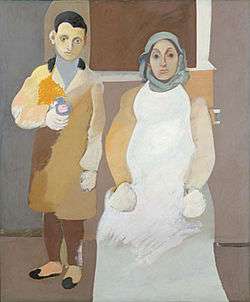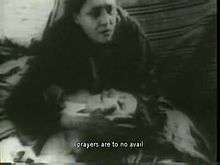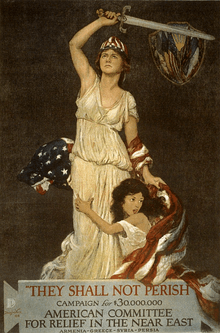Armenian Genocide in culture
Armenian Genocide in culture represents the ways in which people have represented the Armenian Genocide of 1915 in culture, including in art, literature, music and films. Furthermore, there are dozens of Armenian Genocide memorials around the world.
Art

The earliest example of the Armenian genocide in art was a medal issued in St. Petersburg, signifying Russian sympathy for Armenian suffering. It was struck in 1915, as the massacres and deportations were still raging. Since then, dozens of medals in different countries have been commissioned to commemorate the event.[1]
The paintings of Armenian-American Arshile Gorky, a seminal figure of Abstract Expressionism, are considered to have been informed by the suffering and loss of the period.[2] In 1915, at age 10, Gorky fled his native Van and escaped to Russian-Armenia with his mother and three sisters, only to have his mother die of starvation in Yerevan in 1919. His two The Artist and His Mother paintings are based on a photograph with his mother taken in Van.
A case study of Gorky’s 1946-7 painting The Plough and the Song, reveals central themes of suffering and loss, starvation and hunger, and cultural nostalgia emerge through his biomorphic and organically curvilinear forms representing fertility and nature.[3] Through warm, earthy colors, he paints from memory the fertile agricultural lands of his Armenian homeland. He reconstructs a new hybridized identity in America, an amalgam of visual cultural practice of modern art of the West and wistfulness for the rich culture of the Armenian people, reflected in his paintings. The Plough and the Song materializes the dialectic of violence and culture in the fractured history of the Armenian people.
Scholars on Gorky agree that suffering and loss he experienced during the Armenian Genocide strongly informed the production of his modernist paintings in America. Comparisons of Gorky’s The Plough and the Song (1946-7) with works of his contemporaries in the field of organic biomorphic abstraction reveal the stark manifestation of his experiences of brutality and horror. Gorky appears to have systematically developed the imagery of the canvas such that many of his biomorphic forms appear to be “bleeding,” alluding to the horrors and violence he witnessed during the Armenian Genocide. He depicts red far more fluidly, yet systematically. Several of his forms appear to be “bleeding,” given the semblance of a trail of blood that streams down from the inflicted “wounds” on the biomorphic forms. Gorky makes liberal use of shading to deliberately draw attention to the fact that these ebbing blots and streams of red are, in fact, bleeding wounds. Yet, the ironic truth in the way Gorky seems to weld his nostalgia for Armenian culture and rich heritage with the violent history of genocide in a single compositional frame ultimately reflects many Armenians’ own views of their fractured history. There exists a constant dialectic of culture and barbarism in the history of Armenians, where violence persists a theme as constant as the beauty of its culture and its people.
Upon coming to America in the aftermath of the Armenian Genocide, Gorky reconstructed a new identity for himself, as he changed his name from Vosdanig Manoug Adoian to Arshile Gorky, a name that harkened to Georgian-Russian aristocracy and literati of the Caucasus region. In 1922, he enrolled at the New School of Design in Boston, a city, which at that time, was home to a large immigrant population of Armenian Americans. When he later moved to New York, where he taught at the National Academy of Design and the Grand Central School of Art, Gorky was thrown into the briskly evolving realm of modern art. As he began to experiment, his early works began to reflect stylistic elements of Pablo Picasso and Paul Cézanne.[4] In her book, Black Angel: The Life of Archile Gorky, Armenian scholar Nouritza Matossian likens seminal influences on Gorky’s work and style, including Egyptian funerary art for pose, Cézanne for flat planar composition, to Picasso for form and color, and to Ingres for simplicity of line and smoothness. These eclectic attributes that seeped into Gorky’s paintings show the struggle he endured to become recognized by drawing influence from other great masters.[5]
Through the Westernization of Armenian painting, Gorky was able to communicate his worldview: his memories of the fertile, natural beauty of an idyllic agricultural lifestyle in Armenia, a beauty ruptured by the horrors of bloodshed and violence inflicted by the Armenian Genocide on his people. His symbolic depictions of bleeding female fertility against a backdrop of chaos communicate his artistic worldview of how the Late Ottoman Empire ravaged a multi-ethnic empire clean of ethno-linguistic and religious diversity. The dialectic of beauty and violence is one that frames his worldview on representations of genocide through Westernized Armenian painting.
Literature
Several eyewitness accounts of the events were published, notably those of Swedish missionary Alma Johansson and U.S. Ambassador Henry Morgenthau, Sr. German medic Armin Wegner wrote several books about the events he witnessed while stationed in the Ottoman Empire. Years later, having returned to Germany, Wegner was imprisoned for opposing Nazism,[6] and his books were burnt by the Nazis.[7] Probably the best known literary work on the Armenian Genocide is Franz Werfel's 1933 The Forty Days of Musa Dagh. It was a bestseller that became particularly popular among the youth of the Jewish ghettos during the Nazi era.[8]:302–4 Armenian American writer William Saroyan emphasized the Armenians' ability to survive in his 1935 short story The Armenian and the Armenian.[9]
Kurt Vonnegut's 1988 novel Bluebeard features the Armenian Genocide as an underlying theme. Other novels incorporating the Armenian Genocide include Louis de Berniéres' Birds without Wings, Edgar Hilsenrath's German-language The Story of the Last Thought, David Kherdian's The Road from Home and Polish author Stefan Żeromski's 1925 The Spring to Come. A story in Edward Saint-Ivan's 2006 anthology "The Black Knight's God" includes a fictional survivor of the Armenian Genocide.
A penitence for the genocide is a main theme of Stone Dreams (Daş Yuxular), the novel of the Azerbaijani author Akram Aylisli, written in 2006. After the publishing the novel Aylisli was harassed by the state and his books were burnt.[10] The novel Among the Ashes (Küller Arasında), 2009, by the Turkish writer Halil İbrahim Özcan also tells about the Armenian genocide.[11]
Theatre
Richard Kalinoski's play, Beast on the Moon, is about two Armenian Genocide survivors. Anoush Baghdassarian's play, "FOUND," is a historical fiction play about a woman's experience through the Armenian Genocide. It follows the story of a girl named Lucine who is searching for her brother who was taken by Turkish soldiers in 1915 at the start of the genocide. The stage is split in half and while "Old Lucine (1925)" on stage right writes in her diary of memories of the past ten years, "Young Lucine (1915)" acts them out on stage left. It has been performed in New York (2013) and California (2014). In 2014, Devon Jackson's play Nameless premiered at Queen's University in the lead-up to the commemoration of the centenary of the Armenian Genocide. A verbatim theatre play on the Armenian Genocide I Wish To Die Singing – Voices From The Armenian Genocide by Neil McPherson (artistic director) played at the Finborough Theatre, London, from 21 April to 16 May 2015.[12]
Film


The first film about the Armenian Genocide appeared in 1919, a Hollywood production titled Ravished Armenia. It resonated with acclaimed director Atom Egoyan, influencing his 2002 Ararat. There are also references in Elia Kazan's America, America and Henri Verneuil's Mayrig. At the Berlin Film Festival of 2007 Italian directors Paolo and Vittorio Taviani presented another film about the events, based on Antonia Arslan's book, La Masseria Delle Allodole (The Farm of the Larks).[13]
Films
- 1919 – Ravished Armenia, a Hollywood film about the real-life story of survivor Aurora Mardiganian
- 1963 – America America (also known as The Anatolian Smile) (dir. Elia Kazan)
- 1977 – Nahapet
- 1982 – The Forty Days of Musa Dagh (dir. Sarky Mouradian)
- 1988 - Komitas (dir. Don Askarian),[14] ,[15] [16]
- 1990 – Yearning (Karot)
- 1991 – Mayrig by Henri Verneuil
- 1992 - Avetik (dir. Don Askarian),[17] [15]
- 2001 - On the Old Roman Road (dir. Don Askarian),[18] [15]
- 2002 – Ararat (dir. Atom Egoyan)
- 2007 – La Masseria Delle Allodole
- 2009 – Ravished Armenia, restored and edited 24-minute segment of original 1919 film
- 2014 - The Cut (dir. Fatih Akın)
- 2014 - Orphans of the Genocide (dir. Bared Maronian)
- 2015 - 1915 (dir. Garin Hovannisian)
Documentary films
- 1945 – Fatherland (dir. G. Balasanyan, L. Isahakyan and G. Zardaryan)
- 1964 – Where Are My People? (dir. J. Michael Hagopian)
- 1975 – The Forgotten Genocide (dir. J. Michael Hagopian)
- 1983 – Assignment Berlin (dir. Hrayr Toukhanian)
- 1988 – An Armenian Journey (dir. Theodore Bogosian)
- 1988 – Back To Ararat (dirs. Jim Downing, Göran Gunér, Per-Åke Holmquist, Suzanne Khardalian)
- 1991 – The Armenian Genocide (DVD). Thousand Oaks, California: Armenian Film Foundation. 1991. OCLC 60768143.
- 1992 – Secret History: The Hidden Holocaust (dir. Michael Jones)
- 2000 – I Will Not Be Sad in This World (dir. Karina Epperlein)
- 2000 – Destination Nowhere: The Witness (dir. Dr. J. Michael Hagopian)
- 2003 – Germany and the Secret Genocide (dir. Dr. J. Michael Hagopian)
- 2003 – Voices From the Lake: A Film About the Secret Genocide (dir. J. Michael Hagopian)
- 2003 – Desecration (dir. Hrair "Hawk" Khatcherian)
- 2003 – The Armenian Genocide: A Look Through Our Eyes (dir. Vatche Arabian)
- 2004 – My Son Shall Be Armenian (dir. Hagop Goudsouzian)
- 2006 – The Armenian Genocide (dir. Andrew Goldberg)
- 2006 – Screamers (dir. Carla Garapedian)
- 2008 – The River Ran Red (dir. J. Michael Hagopian)
- 2010 – Aghet – Ein Völkermord (dir. Eric Friedler)
- 2011 – Grandma's Tattoos (dir. Suzanne Khardalian)
Music
Here is a list of musical works dedicated to the Armenian Genocide and related events:
| Year | Composition | Artist | Notes |
|---|---|---|---|
| 1915 | Children's Prayer | Komitas | |
| 1916-18 | Zmrkhtuhi | Romanos Melikian | a song cycle |
| 1917 | Take, O Armenia | Alexander Spendiaryan | opus 27, concert aria, words by H. Hovhannisian |
| 1946 | Vorskan akhper | Aram Khachaturian | arrangement for the II Symphony (by Avetik Isahakian) |
| 1961 | Poem about the Armenian People | Alexander Arutiunian | words by Gevork Emin |
| 1964 | The Great Crime | H. Stepanian | words by Paruyr Sevak |
| 1974 | Requiem on Memoriam of Perished People | Loris Tjeknavorian | symphonic work |
| 1975 | Il symphony | G. Hakhinyan | words by Paruyr Sevak |
| 1975 | Ils sont tombés (They Fell) | Charles Aznavour | [19] |
| 1977 | Oratoria-1915 | E. Hayrapetyan | |
| 1978 | The Death | Harutiun Dellalian | a symphonic poem |
| 1984 | A Memorial to the Martyrs | Harutiun Dellalian, Georges Garvarentz and Gostan Zarian | |
| 1984 | The Voice of Victims | Yervand Yerkanyan | a symphony |
| 1985 | Oratorium in Memory of the Victims of the Armenian Genocide of 1915 | Khachatur Avetisyan (music), and Ludwig Doorian (text) | choir, soloïsts, orchestra with traditional instruments |
| 1986 | Sebastia | Krematorij (Armen Grigoryan) | |
| 1998 | P.L.U.C.K. | System of a Down | from the album System of a Down |
| 2000 | A handful of ash from your ashes... | Artin Poturlyan | for harp |
| 2003 | Defixiones, Will and Testament: Orders from the Dead | Diamanda Galás | |
| 2005 | Holy Mountains | System of a Down | from the album Hypnotize |
| 2005 | Adana | Daniel Decker and Ara Gevorgyan | has been translated into 17 languages and recorded by singers around the world.[20] |
| 2008 | Down below | Petros Ovsepyan | |
| 2008 | Tsitsernakabert | Andrey Kasparov | For modern dance and six musicians: alto flute, bass/ contrabass flute, violin, two percussionists, and mezzo-soprano.[21] The work was inspired by the memorial of the same name, situated in Yerevan, capital of Armenia.[22][23] |
| 2008 | Another Land | No One Is Innocent (band) | |
| 2008 | Exploding/Reloading | Scars on Broadway | from the self-titled album Scars on Broadway |
| 2010 | Yes, It's Genocide | Serj Tankian | from the album Imperfect Harmonies |
| 2011 | The Song about Armenia Oratorio | Alexander Brincken | words by D.Varushan, Siamanto, A.Isahakyan and V.Davtyan |
| 2012 | A rainy day in April | Arusyak Sahakian | played by 42 Turkish musicians |
| 2013 | The Armenian Genocide | Julian Cope | from the album Revolutionary Suicide |
| 2013 | Open Wounds | R-Mean | from the album Broken Water |
| 2014 | In the Shadow of Ararat | Joseph Bohigian | for flute, clarinet, violin, cello, vibraphone, and piano |
| 2015 | Cantata for Living Martyrs | Serouj Kradjian | for orchestra and chorus |
| 2015 | Silent Cranes | Mary Kouyoumdjian | for string quartet (commissioned by Kronos Quartet) |
| 2015 | Aprelu April | Inga and Anush Arshakyan | |
The American band System of a Down, composed of four descendants of Armenian Genocide survivors, has promoted awareness of the Armenian Genocide through its lyrics, including P.L.U.C.K. and in concerts.[24]
In late 2003, Diamanda Galás released the album Defixiones, Will and Testament: Orders from the Dead, an 80-minute memorial tribute to the Armenian, Assyrian and Greek victims of the genocide in Turkey. "The performance is an angry meditation on genocide and the politically cooperative denial of it, in particular the Turkish and American denial of the Armenian, Assyrian, and Anatolian Greek genocides from 1914 to 1923".[25]
Gallery
-

They Shall Not Perish: American Committee for Relief in the Near East, poster by Douglas Volk, 1918.
-

Political cartoon portraying Sultan Hamid as a butcher for his harsh actions against the Ottoman Armenians
-

"John Bull hated to drop his bundle..." Political cartoon about "England's commercial interests in the Orient". The woman represents Armenia.
-

Philadelphia Museum of Art - Armenian Genocide memorial
See also
References
- ↑ Sarkisyan, Henry (1975). Works of the State History History Museum of Armenia. IV: Armenian Theme in Russian Medallic Art. Yerevan: Hayastan. p. 136.
- ↑ Arshile Gorky and the Armenian genocide, Find Articles.
- ↑ The Plough and the Song, 1946. The Art Institute of Chicago. <http://www.artic.edu/aic/collections/artwork/16964>
- ↑ “Arshile Gorky: Water of the Flowery Mill (56.205.1)”. In Heilbrunn Timeline of Art History. New York: The Metropolitan Museum of Art, 2000 <http://www.metmuseum.org/toah/works-of-56.205.1> (October 2006)
- ↑ Matossian, Nouritza. Black Angel, The Life of Arshile Gorky. Overlook Press, NY 2000, pp. 214–215.
- ↑ Document: Armin T. Wegner's Letter to German Chancellor Adolf Hitler, Berlin, Easter Monday, April 11, 1933 – Gerlach and Templer 8 (3): 395 – Holocaust and Genocide Studies.
- ↑ Autorenseite Wegners (in German), DE: Aktion Patenschaften für verbrannte Bücher, archived from the original on 2008-05-21.
- ↑ Yair Auron (2000). The banality of indifference: Zionism & the Armenian genocide. Transaction Publishers. p. 44. ISBN 978-0-7658-0881-3. Retrieved 26 February 2012.
- ↑ Shirinian, Lorne (2000). Writing memory: the search for home in Armenian diaspora literature as cultural practice. Kingston, Ontario: Blue Heron Press. p. 86. ISBN 9780920266229.
- ↑ “It is like being pregnant all your life..." Akram Aylisli is the first Turkic author who has written a novel about the Armenian Genocide
- ↑ Ermeni tehciri üzerine cesur bir roman
- ↑ http://www.theguardian.com/stage/2015/apr/26/i-wish-to-die-singing-searing-account-of-armenian-genocide
- ↑ Wolfgang Höbel and Alexander Smoltczyk. "Armenian Genocide at the Berlin Film Festival: "The Lark Farm" Wakens Turkish Ghosts". Spiegel Online. Retrieved 2007-09-06.
- ↑
- 1 2 3
- ↑
- ↑
- ↑
- ↑ Mari Terzian. "The status of Armenian communities living in the United States". Azad-Hye. Archived from the original on 28 September 2007. Retrieved 2007-09-06.
- ↑ "Gospel Artist Given Standing Ovation By Armenian Government Officials". ANS. Archived from the original on 9 October 2007. Retrieved 2007-09-06.
- ↑ Old Dominion University (2008-03-18). "Old Dominion University Calendar | Diehn CREO Concert: The Synergy of Dance, Art and Music". Ww2.odu.edu. Retrieved 2013-03-07.
- ↑ Rutherford, Laine M. “Composer and troupe pay tribute to Armenia.” Virginian-Pilot 15 March 2008: E5.
- ↑ Rutherford, Laine M. “Tsitsernakabert: Original piece makes a powerful statement.” Virginian-Pilot 19 March 2008: E5.
- ↑ Line Abrahamian. "Talking With Turks and Armenians About the Genocide". Reader's Digest Canada. Retrieved 2007-04-23.
- ↑ Galás, Diamanda. "Defixiones: Orders from the Dead". The San Francisco Chronicle. Archived from the original on 11 October 2007. Retrieved 2007-10-05.
External links
Art
- The Armenian Genocide — 95 Years Later, In Remembrance
- Armenian Genocide in Art
- Armenian Genocide in Contemporary Graphic and Art Posters
- Armenian Genocide Photo Collections
- Art, Memory, and the Armenian Genocide, by Stephen Feinstein
- Turkish Soup Made with Armenian Bones, documentary film by Souren Karapetian about Zareh's artwork dedicated to Armenian Genocide.
Music
- Open Wounds samples Kilikia and has Armenian Chorus
- A rainy day in April (compiled by Arusyak Sahakian, played by 42 Turkish musicians)
- The Death by H. Dellalian
- The Armenian Question, encyclopedia, Ed. by acad. K. Khudaverdyan, Yerevan, 1996, pp. 322–323.
- Talking With Turks and Armenians About the Genocide// Reader's Digest, Canada
- The status of Armenian communities living in the United States
- Gospel Artist Given Standing Ovation By Armenian Government Officials
Film
- The American Genocide (1991 film)
- Grandma's Tattoos (2011 documentary)
- Film's about the Armenian Genocide